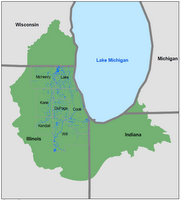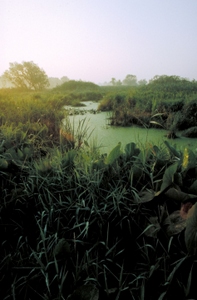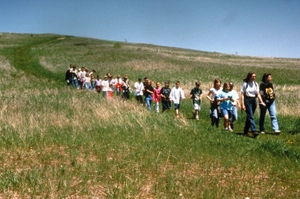 Conservation biologists estimate that between 20 and 30 percent of land cover should be protected as habitat to maintain adequate numbers of plants species (Shore, 2005). Although the region is not there yet, the Chicago Wilderness Region is nationally recognized for ecosystem restoration and preservation. The Chicago Wilderness Region has more than 225,000 acres of protected conservation land with some of the best surviving woodlands, wetlands, and prairies in the Midwest (Chicago Wilderness). The majority of the protected land lies within the region's seven forest preserves and conservation districts. The map below shows protected land as well as restoration sites. These achievements are a result of many partnerships in the region as well as at the state and federal level. The following sections focus on the major players in ecosystem restoration.
Conservation biologists estimate that between 20 and 30 percent of land cover should be protected as habitat to maintain adequate numbers of plants species (Shore, 2005). Although the region is not there yet, the Chicago Wilderness Region is nationally recognized for ecosystem restoration and preservation. The Chicago Wilderness Region has more than 225,000 acres of protected conservation land with some of the best surviving woodlands, wetlands, and prairies in the Midwest (Chicago Wilderness). The majority of the protected land lies within the region's seven forest preserves and conservation districts. The map below shows protected land as well as restoration sites. These achievements are a result of many partnerships in the region as well as at the state and federal level. The following sections focus on the major players in ecosystem restoration.
Ecosystem Protection and Restoration Efforts
Sep 10, 2013
Ecosystem Protection and Restoration Efforts in our Region
Federal Government
The federal government establishes a broad basis for policy guidance, regulation, and protection of natural lands in the nation. The U.S. Forest Service, a unit of the United States Department of Agriculture, manages national forests and grasslands equivalent to 193 million acres (U.S. Forest). Although the U.S. Forest Service only owns 6% of Illinois' forest land, federal involvement assists states with meeting their overarching environmental resource goals (Crocker and Little, 2006). Additionally, the U.S. Army Corps of Engineers operates a district in the region with several ongoing projects that focus on ecosystem restoration including the Butler Lake Restoration project. Located in Libertyville, the project aims to decrease erosion, restore native plant species and repair fish habitats. This project is currently underway and has a budget is $3.35 million; 70% of the funding is being provided by the federal government (US Army Corps of Engineers). Click here for more detail on relevant federal agencies.
State Government
Illinois establishes specific policies and legislation on managing natural resources within the state boundary. The Illinois Department of Natural Resources (IDNR) is a primary organization for environmental resource protection and planning. Since 1994, IDNR has operated the Critical Trends Assessment Program, which collects and reports statewide data on the conditions of ecosystems to determine the best natural resources policies. For the program, professional scientists monitor 600 randomly selected private and public sites in four habitats (forests, grasslands, wetlands and streams) around the state (IDNR). IDNR also provides several grant programs to encourage ecosystem restoration and the preservation of the region's resource as well as offer educational activities and recreational improvements. Since 1995, the Conservation 2000 (C2000) program has offered grant opportunities based on a broad-based long term approach to protecting and managing Illinois' natural resources. This program seeks to not only involve public agencies but private and corporate landowners while involving the interest and participation of local communities. As of 2008, C2000 now known as Partners for Conservation was extended until 2021 when House Bill 1780 was signed into law (Ibid). The Ecosystems Program is funded through Partners for Conservation to "enhance and protect watersheds through ecosystem-based management. This program consists of Ecosystem Partnerships, coalitions of local stakeholders that are united by the programs purpose. 41 Ecosystem Partnerships are currently active covering 84% of the state's landscape and encompassing 98% of the states citizens.
"To date more than 70,500 acres have been restored. Nearly 5,600 acres have been protected through conservation easements or simple acquisition. More than $34.9 million in project grants have been awarded. Recipients have provided another $33.4 million in match. Nearly a half million citizens of all ages have been educated on natural resource protection" (IDNR).
For more information on conservation incentive programs in Illinois, click here.
For more detail on relevant state agencies click here.
Local Governments and Non-Profits
Coordination and cooperation between local governments (county, township, municipal) and non-profit organizations is necessary to protect and preserve local natural resources. These agencies play various roles, including encouraging stewardship, increasing awareness, disputing harmful activities and influencing policies that protect natural resources.
Several non-profit agencies work together to promote and implement ecosystem restoration activities in Illinois. The Chicago Wilderness Consortium is an organization with over 230 members that have all committed to protecting, restoring, and managing Chicago's regional natural resources (Chicago Wilderness). One such member organization, Openlands, focuses on "preserving and enhancing public open space" in the northeastern Illinois region. Through active leadership, Openlands has assisted with securing more than 45,000 acres of wetlands, forest preserves, parks, bike and water trails and gardens (Openlands). Click here for more detail on relevant local and non-profit agencies.
Forest Preserves and Conservation and Park Districts
 |
|
Brewster Creek at Pratt's Wayne Woods Forest Preserve, Forest Preserve District of DuPage County. |
The northeastern Illinois region is particularly fortunate because all 7 counties have a well-established forest preserve or conservation district. These districts' acquire land in order to protect and preserve open space and natural communities within their counties. Additionally forest preserves and conservation district facilitate public education and develop resident interest in natural areas as well as provide recreational opportunities. Together they are absolutely essential to ecosystem restoration in the region, with holdings of more than 170,000 acres. Although typically more focused on recreation, many of the 148 park districts in our region also actively participate in preservation and restoration including the St. Charles and Chicago park districts (Chicago Region Biodiversity Council, 1999).
CMAP Region's Forest Preserve and Conservation Districts
- Cook County (approx. 67,000 acres)
- DuPage County (approx. 25,000 acres)
- Kane County (approx. 17,800 acres)
- Kendall County (approx. 2160 acres)
- Lake County (approx. 26,000 acres)
- McHenry County (approx. 20,000 acres)
- Will County (approx. 15,000 acres)
Private Sector
Private companies are also active in ecosystem restoration. ComEd has several restoration sites in the region including Buffalo Grove Prairie (10 acres) in Lake County and a 100-acre site in DuPage County. These sites utilize a portion of the 40,000 acres ComEd owns under power lines called "right of ways." In comparison only one forest preserve district in the region, Cook County, holds more land. ComEd restored to native prairie landscapes to these sites while still maintaining the functions necessary for the company. Partnerships with local and state government agencies along with the help of volunteers have made these projects possible (Shore 2005). For more information click here.
Volunteers and Public Support
 |
|
Kids on Prairie Trail, McHenry County Conservation District |
Many of the Chicago Wilderness member organizations, as well as the county forest preserve, conservation and park districts offer volunteer opportunities. Volunteers participate in a wide variety of activities including stream cleanups, bird counting, seed planting and invasive species removal as well as providing guides and docent services for educational programs. As a valuable extension of paid staff, they provide an important benefit to restoration and preservation agencies that have limited resources. Many of the region's restoration projects would not be possible without dedicated volunteers.
The public is also a key player in ecosystem restoration efforts. Our forest preserves, conservation and park districts often have opportunities to gain additional funding to buy new land or increase active maintenance of current preserves through voter approved referendums. Most recently, in November 2008, a successful referendum in Lake County provided the Lake County Forest Preserves with $185 million to "create new trails, restore lost wildlife habitats and improve public access to new and existing preserves-all without a tax rate increase" (Lake County Forest Preserve District).
Sep 10, 2013
Ecosystem Protection and Restoration Efforts in our Region
 Conservation biologists estimate that between 20 and 30 percent of land cover should be protected as habitat to maintain adequate numbers of plants species (Shore, 2005). Although the region is not there yet, the Chicago Wilderness Region is nationally recognized for ecosystem restoration and preservation. The Chicago Wilderness Region has more than 225,000 acres of protected conservation land with some of the best surviving woodlands, wetlands, and prairies in the Midwest (Chicago Wilderness). The majority of the protected land lies within the region's seven forest preserves and conservation districts. The map below shows protected land as well as restoration sites. These achievements are a result of many partnerships in the region as well as at the state and federal level. The following sections focus on the major players in ecosystem restoration.
Conservation biologists estimate that between 20 and 30 percent of land cover should be protected as habitat to maintain adequate numbers of plants species (Shore, 2005). Although the region is not there yet, the Chicago Wilderness Region is nationally recognized for ecosystem restoration and preservation. The Chicago Wilderness Region has more than 225,000 acres of protected conservation land with some of the best surviving woodlands, wetlands, and prairies in the Midwest (Chicago Wilderness). The majority of the protected land lies within the region's seven forest preserves and conservation districts. The map below shows protected land as well as restoration sites. These achievements are a result of many partnerships in the region as well as at the state and federal level. The following sections focus on the major players in ecosystem restoration.
Federal Government
The federal government establishes a broad basis for policy guidance, regulation, and protection of natural lands in the nation. The U.S. Forest Service, a unit of the United States Department of Agriculture, manages national forests and grasslands equivalent to 193 million acres (U.S. Forest). Although the U.S. Forest Service only owns 6% of Illinois' forest land, federal involvement assists states with meeting their overarching environmental resource goals (Crocker and Little, 2006). Additionally, the U.S. Army Corps of Engineers operates a district in the region with several ongoing projects that focus on ecosystem restoration including the Butler Lake Restoration project. Located in Libertyville, the project aims to decrease erosion, restore native plant species and repair fish habitats. This project is currently underway and has a budget is $3.35 million; 70% of the funding is being provided by the federal government (US Army Corps of Engineers). Click here for more detail on relevant federal agencies.
State Government
Illinois establishes specific policies and legislation on managing natural resources within the state boundary. The Illinois Department of Natural Resources (IDNR) is a primary organization for environmental resource protection and planning. Since 1994, IDNR has operated the Critical Trends Assessment Program, which collects and reports statewide data on the conditions of ecosystems to determine the best natural resources policies. For the program, professional scientists monitor 600 randomly selected private and public sites in four habitats (forests, grasslands, wetlands and streams) around the state (IDNR). IDNR also provides several grant programs to encourage ecosystem restoration and the preservation of the region's resource as well as offer educational activities and recreational improvements. Since 1995, the Conservation 2000 (C2000) program has offered grant opportunities based on a broad-based long term approach to protecting and managing Illinois' natural resources. This program seeks to not only involve public agencies but private and corporate landowners while involving the interest and participation of local communities. As of 2008, C2000 now known as Partners for Conservation was extended until 2021 when House Bill 1780 was signed into law (Ibid). The Ecosystems Program is funded through Partners for Conservation to "enhance and protect watersheds through ecosystem-based management. This program consists of Ecosystem Partnerships, coalitions of local stakeholders that are united by the programs purpose. 41 Ecosystem Partnerships are currently active covering 84% of the state's landscape and encompassing 98% of the states citizens.
"To date more than 70,500 acres have been restored. Nearly 5,600 acres have been protected through conservation easements or simple acquisition. More than $34.9 million in project grants have been awarded. Recipients have provided another $33.4 million in match. Nearly a half million citizens of all ages have been educated on natural resource protection" (IDNR).
For more information on conservation incentive programs in Illinois, click here.
For more detail on relevant state agencies click here.
Local Governments and Non-Profits
Coordination and cooperation between local governments (county, township, municipal) and non-profit organizations is necessary to protect and preserve local natural resources. These agencies play various roles, including encouraging stewardship, increasing awareness, disputing harmful activities and influencing policies that protect natural resources.
Several non-profit agencies work together to promote and implement ecosystem restoration activities in Illinois. The Chicago Wilderness Consortium is an organization with over 230 members that have all committed to protecting, restoring, and managing Chicago's regional natural resources (Chicago Wilderness). One such member organization, Openlands, focuses on "preserving and enhancing public open space" in the northeastern Illinois region. Through active leadership, Openlands has assisted with securing more than 45,000 acres of wetlands, forest preserves, parks, bike and water trails and gardens (Openlands). Click here for more detail on relevant local and non-profit agencies.
Forest Preserves and Conservation and Park Districts
 |
|
Brewster Creek at Pratt's Wayne Woods Forest Preserve, Forest Preserve District of DuPage County. |
The northeastern Illinois region is particularly fortunate because all 7 counties have a well-established forest preserve or conservation district. These districts' acquire land in order to protect and preserve open space and natural communities within their counties. Additionally forest preserves and conservation district facilitate public education and develop resident interest in natural areas as well as provide recreational opportunities. Together they are absolutely essential to ecosystem restoration in the region, with holdings of more than 170,000 acres. Although typically more focused on recreation, many of the 148 park districts in our region also actively participate in preservation and restoration including the St. Charles and Chicago park districts (Chicago Region Biodiversity Council, 1999).
CMAP Region's Forest Preserve and Conservation Districts
- Cook County (approx. 67,000 acres)
- DuPage County (approx. 25,000 acres)
- Kane County (approx. 17,800 acres)
- Kendall County (approx. 2160 acres)
- Lake County (approx. 26,000 acres)
- McHenry County (approx. 20,000 acres)
- Will County (approx. 15,000 acres)
Private Sector
Private companies are also active in ecosystem restoration. ComEd has several restoration sites in the region including Buffalo Grove Prairie (10 acres) in Lake County and a 100-acre site in DuPage County. These sites utilize a portion of the 40,000 acres ComEd owns under power lines called "right of ways." In comparison only one forest preserve district in the region, Cook County, holds more land. ComEd restored to native prairie landscapes to these sites while still maintaining the functions necessary for the company. Partnerships with local and state government agencies along with the help of volunteers have made these projects possible (Shore 2005). For more information click here.
Volunteers and Public Support
 |
|
Kids on Prairie Trail, McHenry County Conservation District |
Many of the Chicago Wilderness member organizations, as well as the county forest preserve, conservation and park districts offer volunteer opportunities. Volunteers participate in a wide variety of activities including stream cleanups, bird counting, seed planting and invasive species removal as well as providing guides and docent services for educational programs. As a valuable extension of paid staff, they provide an important benefit to restoration and preservation agencies that have limited resources. Many of the region's restoration projects would not be possible without dedicated volunteers.
The public is also a key player in ecosystem restoration efforts. Our forest preserves, conservation and park districts often have opportunities to gain additional funding to buy new land or increase active maintenance of current preserves through voter approved referendums. Most recently, in November 2008, a successful referendum in Lake County provided the Lake County Forest Preserves with $185 million to "create new trails, restore lost wildlife habitats and improve public access to new and existing preserves-all without a tax rate increase" (Lake County Forest Preserve District).